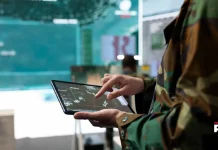Imagine a technological breakthrough that can generate your virtual counterpart. The digital twin is a cutting-edge technology that holds the potential to transform industries, blurring the boundaries between the physical and digital domains.
So, without further ado, let us delve into the intricacies of this remarkable technology.
What is a Digital Twin, Exactly?
A digital twin refers to a virtual representation of physical objects, systems, or processes that mirrors its real-world counterpart. It spans the entire lifecycle of the physical entity and utilizes real-time data from sensors to simulate behavior and monitor operations. These twins offer numerous benefits, including improved performance, real-time insights, and predictive capabilities.
The technology has been rapidly growing in recent years. According to a recent analysis by Extrapolate, the global digital twin market is likely to be worth about $89.45 billion by 2030, at a compound annual growth rate (CAGR) of 34.48% over 2022-2030. The statistic shows the immense growth of this sector in the coming years.
How Does Digital Twin Work?
Digital twin technology works by creating a virtual representation, allowing for the simulation and prediction of its behavior in the real world. This digital replica, often powered by a combination of 3D modeling, sensor data, and artificial intelligence, enables businesses to monitor, analyze, and optimize the performance of their physical assets, systems, or processes.
By utilizing real-world data, these twins provide insights that can be used to prevent problems, optimize operations, develop new opportunities, and plan for the future through simulations. Ultimately, the twin technology serves as a bridge between the physical and digital worlds, offering a powerful tool for understanding and optimizing real-world systems and processes.
Exploring the Industrial Applications of Digital Twin Technology
The twin technology has diverse applications across various industries, revolutionizing processes and decision-making. Below is some of its key in different sectors:
● Healthcare
In the healthcare industry, technology is employed for personalized medicine, patient monitoring, and medical device simulation. They facilitate the development of virtual patient models for treatment planning and predictive analytics for healthcare management.
● Retail
Retailers leverage twin technology for design, planning, and operations. They generate 3D virtual stores to visualize and simulate the optimal experience before construction, employ planograms for space optimization, and integrate 3D assets into e-commerce sites to enhance customer experiences.
● Supply Chain and Logistics
This technology plays a crucial role in supply chain and logistics, enabling real-time monitoring and analysis for performance optimization. They are used for inventory management, predictive maintenance of transportation assets, and enhancing overall operational efficiency.
● Energy and Utilities
This twin technology is increasingly used in the energy and utilities sectors for asset performance management, predictive maintenance of power-generation turbines, and real-time monitoring of equipment. They contribute to improved operational efficiency and reduced downtime.
● Aerospace and Automotive Industries
In the aerospace and automotive sectors, it acts as an essential tool for optimizing manufacturing value chains, vehicle engineering, and maintenance. They facilitate accurate stipulation of weather conditions, vehicle defect detection, and remote training and monitoring of equipment.
● Urban Planning and Civil Engineering
Civil engineers and urban planners benefit significantly from this technology, which provides real-time 3D and 4D spatial data for urban planning activities. They aid in visualizing and simulating urban environments, contributing to accurate and informed decision-making.
● Smart Manufacturing
These twins are extensively used in smart manufacturing for virtual modeling, simulation, and optimization of production processes. It enables preventive maintenance, quality control, and real-time equipment monitoring, leading to improved efficiency and reduced downtime.
Organizations such as IBM have played a significant role in shaping technological advancements, which emphasizes the role of twin technology in Industry 4.0.
How Can Digital Twin Technology Boost Business Growth?
Twin technology can significantly contribute to the growth of the business by offering a range of benefits and opportunities. By using twin technology, businesses can achieve accelerated risk assessment and production, implement predictive maintenance strategies, enhance team collaboration, enable real-time remote monitoring, and make better financial decisions.
Furthermore, twin technology can transform various aspects of business operations, such as supply chain management, stock monitoring, and inventory management. For example, Siemens’ digital twin solutions optimize manufacturing processes and ensure product efficiency under various construction phases.
This technology enables the modeling and stress testing of potential breaking points in the supply chain, leading to improved resiliency and risk management. Moreover, using digital twin software such as Azure Digital Twins, businesses can create custom domain models of their surroundings and do live execution and graph representation.
To Wrap Up
Digital twin technology stands at the forefront of innovation, offering remarkable potential to revolutionize industries, enhance decision-making, optimize operations, and drive unprecedented growth. As businesses continue to embrace the power of twin technology, the seamless integration of virtual and physical realms will undoubtedly pave the way for new opportunities, increased efficiency, and a deeper understanding of complex systems. The future of digital twin technology holds the promise of transforming the way we interact with and manage our physical assets, processes, and environments. This evolution ultimately contributes to shaping a more connected and intelligent world.
Browse More Posts:-
Airlaid Paper Market
Artificial Turf Market
Athletic Socks Market
Barbecue Grill Charcoal Market




